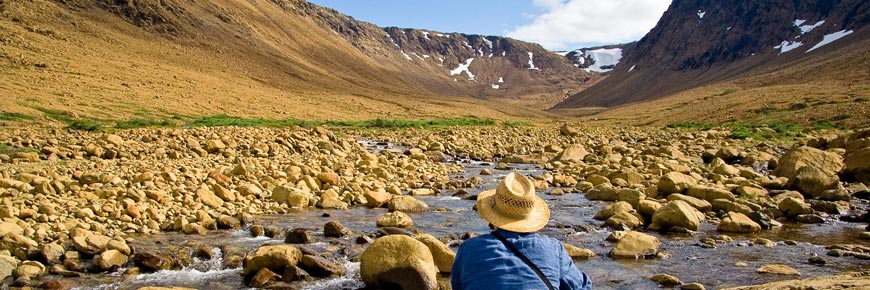
Gros Morne National Park
Newfoundland and Labrador
Date of Inscription: 1987(ext. 9 Dec 1990)
The scenery at Gros Morne ranks among the most spectacular in Eastern Canada: sharp ridges and huge cliffs, coastal bogs and highland tundra, dramatic ocean inlets and lakes. And yet it is not primarily this exceptional natural beauty that has earned the park a spot on the World Heritage List, but rather its remarkable geology.
Justification of outstanding universal value
Gros Morne National Park was designated as a World Heritage site by UNESCO’s World Heritage Committee under the following criteria:
Criterion (vii): Gros Morne National Park, an outstanding wilderness environment of spectacular landlocked, freshwater fjords and glacier-scoured headlands in an ocean setting, is an area of exceptional natural beauty.
Criterion (viii): The rocks of Gros Morne National Park collectively present an internationally significant illustration of the process of continental drift along the eastern coast of North America and contribute greatly to the body of knowledge and understanding of plate tectonics and the geological evolution of ancient mountain belts. In glacier-scoured highlands and spectacular fjords, glaciation has made visible the park’s many geological features.
Full description
The park is considered a textbook illustration of plate tectonics, the theory that suggests continent-sized plates of the Earth’s crust have collided and separated repeatedly over geological time, opening and closing oceans between them.
Six hundred million years ago, Europe and North America were joined but were starting to pull apart. Magma from the lower crust welled up and filled the gap between them - the solidified magma is now visible in the cliffs of Gros Morne’s Western Brook Pond. From 570 to 420 million years ago, there was an ocean between the two continents called the Iapetus Sea. Sedimentary strata in the park preserve fossils of almost every phylum known to exist during that time - a virtual catalogue of evolution. By 460 million years ago, North America and Europe were pressing together, raising the Appalachian Mountains and closing the Iapetus Sea. Some blocks of oceanic crust and mantle were transported west and raised to the surface of the earth. Eons later, glacial ice scoured the area, creating fiords and cutting transects of the mountains that reveal their geological past.
More Information
Parks Canada:
Gros Morne National Park of Canada
World Heritage Centre:
Related links
- Anticosti, Quebec
- Tr’ondëk-Klondike, Yukon
- Writing-on-Stone / Áísínai’pi
- L’Anse aux Meadows National Historic Site
- Nahanni National Park Reserve
- Dinosaur Provincial Park
- Kluane / Wrangell-St.Elias / Glacier Bay /...
- Head-Smashed-In Buffalo Jump
- SG̱ang Gwaay
- Wood Buffalo National Park
- Canadian Rocky Mountain Parks
- Historic District of Old Québec
- Old Town Lunenburg
- Waterton-Glacier International Peace Park
- Miguasha National Park
- Rideau Canal
- Joggins Fossil Cliffs
- Landscape of Grand Pré
- Red Bay Basque Whaling Station
- Mistaken Point
- Pimachiowin Aki
- Date modified :